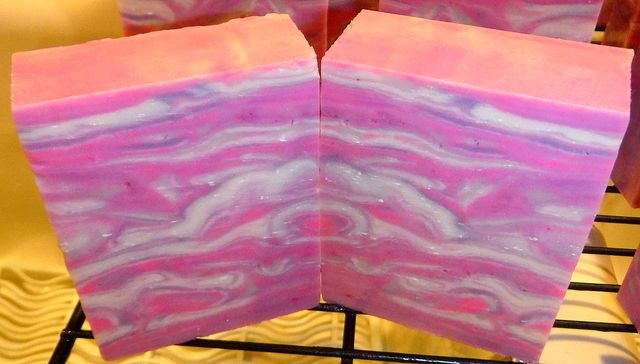Reporting on my impressions of using this soap at 6 months cure with a comparison to 15-month cured Castile. For the younger Castile, I used the pink one, which is 100% OO of the Kirkland brand, which comes from Costco. The older Castile was made with Sam's Club OO because that's what I had on hand (I don't actually live very close to a Costco, but I do live close to Sam's Club.)
I don't have a 6 month young bar of single lye Castile to compare it to, but I do believe my results belie the statement that a 4-6 week cure for dual lye Castile is sufficient to eliminate slime or that has cured enough to be mild.
Other than the lye composition, the amount of water and the addition of micas to the newer soap, the recipes are exactly the same. Olive Oil and water, same 5% SF, both done CP (although at this point I don't think that would matter.)
Single Lye Castile (15 months of age):
Copious large to medium bubbles; absolutely no slime; fairly creamy lather than starts a little slower and takes a bit longer to become creamy, but feels very good on my skin. After washing and rinsing, there seems to be a residual conditioning or nourishing feel to my skin that lasts nicely.
Notes about the bar & recipe: I made this with full water per SoapCalc's default. It is softer, not yet 'rock hard' like the pink bar below.
Dual Lye Castile (95% NaOH + 5% KOH) (6 months of age):
Slightly smaller, but abundant bubbles; copious thick and creamy lather; slime forms when I hold my palm flat on the bar and lift it away, breaking at about 1 to 1.5 inches from the surface as I lift my hand; HOWEVER, this slime goes away when I used the same bar twice and I had a hard time re-creating the slime after the initial one minute of soaping up my hands. After using this 6-month young Dual Lye Castile, my skin feel dryer than I like. Not as mild and not as 'conditioned' or 'nourished' or whatever that feeling is when a soap doesn't leave my hands feeling like they would benefit from some lotion.
Notes about the bar & recipe: I made this with a [40% Lye Concentration] so less water. It is very hard, although it did bow a bit while drying, which the other one did not, but I suspect that has to do with not turning the bar as frequently to prevent bowing.
The temperature of the water seems to make no difference whatsoever on these findings. At first I used warm water. Later I re-tested with cold water accidentally, but it was actually interesting to see that it made no difference. Then I repeated it with warm water again almost immediately. That's when I discovered the slime is harder to 'find' in the dual lye Castile when washing the soap, rinsing the soap and re-washing again right away.
Also of interest, is that when my hands felt dryer than I like after using the dual lye Castile, about 10 minutes later I simply washed again with the 15-month old Castile and my hands feel better again. Odd that.
In any case, I do believe that even if some say you can use a Dual Lye Castile earlier (at 4-6 weeks), I would NOT recommend it. Even at 6 months, it's not anywhere near as mild as it should be in my opinion.


















































